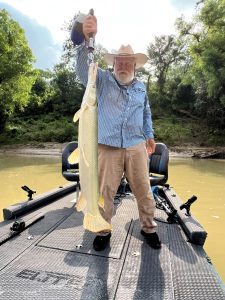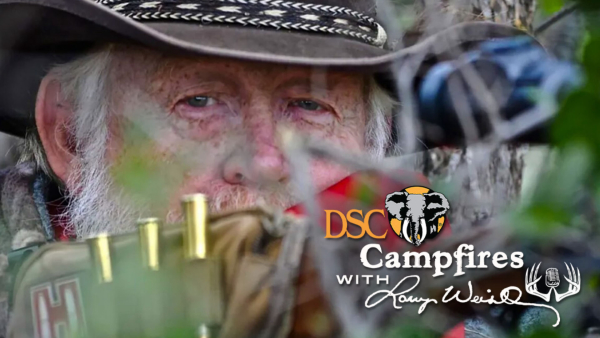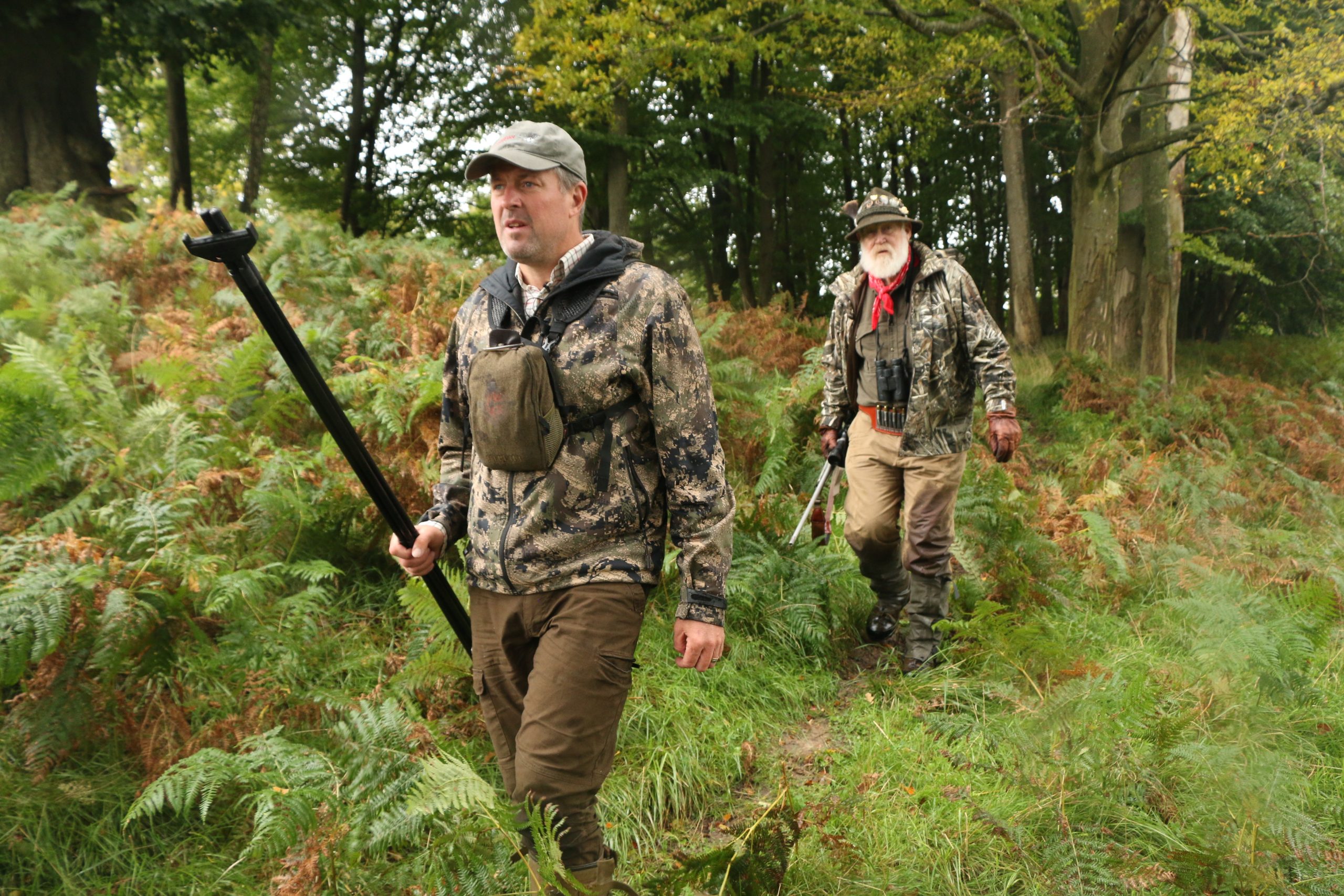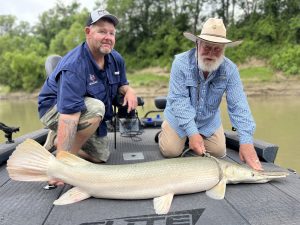 Blog by Larry Weishuhn
Blog by Larry Weishuhn
“Let her run. She’ll soon stop, mouth the bait a bit and then take off again. Sometimes they’ll do that two or three times before trying to swallow the bait. Most people try to set the hook too early when they’re simply holding the bait in their mouth,” said guide Chris Moody. Conor Harrison listened intently, allowing more line to be taken. After another “run” of likely 30 feet, Chris spoke again.
“She’s stopped and now likely will swallow the bait. Reel in slack. When you set the hook do so like you’re swinging for the fence, pulling backwards as hard as you can. Then immediately start reeling!”
I watched as Conor did just as Chris Moody, who owns and operated Alligator Gar Addictions, instructed. When he set the hook, it was like he had hooked onto a log deep in the Trinity River’s channel, other than almost immediately whatever he was hooked into was moving and taking line.
“Reel”, instructed Chris while at the same time starting to maneuver the boat toward where the line disappeared into the water.
Conor was reeling, taking line, until whatever was on the end of the line turned to our right, and again started taking line. I watched line coming out of the water. At the same time, Chris said, “She’s gonna jump!” Just then a near 6-feet long alligator gar cleared the Trinity’s murky water in a manner that would have made a tarpon or sailfish jealous! I heard Conor gasp, “Oh my…” The big gar fell into the water with a loud splash. The fight continued, the gar pulling away, then for a brief time swimming right toward the boat. Conor reeled, taking in the slacked line. Eight feet from the boat, the big gar turned abruptly left and immediately again started pulling drag. I watched line coming to the surface. The big alligator gar cleared water, showing a toothy grin! When she fell into the water said Chris, “Think she’s starting to tire. Bring her alongside. We’ll see if she’s “green” or if she’s tired.”
Up next to the boat the big alligator gar turned and made one more run. Conor held on and then again started reeling. She was tiring, and, I suspect the fisherman was as well. When the gar came alongside, Chris prepared his “lariat” so he could loop the rope right behind the pectoral fins and pull it tight before trying to pull her on board. The big gar skittered through the loop. With his second attempt Chris secured the rope where he wanted and started pulling the gar onto the boat.
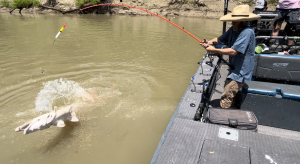 I pushed a congratulatory hand toward Conor, which he took and shook enthusiastically. I totally understood his excitement. I was nearly as excited for him as he was for himself. While we prepared for photographs, Tracy, Chris’ beautiful and gracious wife grabbed a measuring tape and a round string-like tag, which she poked into the gar just to the side and behind the dorsal fin. After recording the number of the tag, she measured from tip of nose to tip of tail, 67-inches, “Five-feet, seven-inches.” Said she with a smile.
I pushed a congratulatory hand toward Conor, which he took and shook enthusiastically. I totally understood his excitement. I was nearly as excited for him as he was for himself. While we prepared for photographs, Tracy, Chris’ beautiful and gracious wife grabbed a measuring tape and a round string-like tag, which she poked into the gar just to the side and behind the dorsal fin. After recording the number of the tag, she measured from tip of nose to tip of tail, 67-inches, “Five-feet, seven-inches.” Said she with a smile.
“Probably weighs about 60 or so pounds,” commented Chris. He continued, “Interesting thing about alligator gars is their first three or so years they grow fairly quickly, but then after that they, based on what we’re learning from the gars we’ve tagged here on the Trinity, they grow about a half-inch per year. Your old gal has some age on her.” Before Conor could ask a question, said Chris, “Pretty much all big alligator gars are females. Females tend to get bigger than males.”
“There are several interesting things about alligator gars. Essentially, they have not changed in the last 50 million years, based on fossil records. Mother Nature seldom messes with perfection.”
Chris moved around to the head and pointed at the teeth.
“The bottom jaw’s teeth fit into a channel between two rows of teeth on the top. Too, if you’ll look closely the sharp tips of the teeth are a bit larger than the shank of the teeth. The upper muzzle of alligator gars also allows for some linear separation. This allows the gar to swallow larger chunks of food than they would otherwise be able to.”
Pointing at the front tip of the gar’s muzzle, “Alligator gars have four nostrils, two on top and two lower down the frontal tip of the upper jaw. And as you know they can breathe air, and often surface to gulp air. While we’re on the river today you’ll hear them surface, but then also slap the water as well. Too, their scales are really bony scutes that interlock.”
Conor was all grins and smiles. We took numerous photos then gently pushed his gar back into the river. Said he, “It would be a shame not to return her to the river, where she might again be caught in the future.”
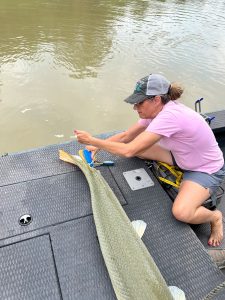 “With our tagging program we have caught several of our tagged gars at least a couple of times and some even more.” Turning toward me, “Larry that six-footer you caught with me on your first trip, we’ve caught her three more times. Interestingly only a short distance from were we initially tagged her. Some of our tagged fish we have caught several miles from where they were tagged.”
“With our tagging program we have caught several of our tagged gars at least a couple of times and some even more.” Turning toward me, “Larry that six-footer you caught with me on your first trip, we’ve caught her three more times. Interestingly only a short distance from were we initially tagged her. Some of our tagged fish we have caught several miles from where they were tagged.”
Having booked my gar fishing trip with Chris (www.garfishingaddiction.com) I asked Conor Harrison, who is DSC’s Communications Director, including being the editor of DSC’s GAME TRAILS magazine, to join me. Conor and I had first met several years earlier through DSC. I knew him to originally be from Florida, and someone who not only loved to hunt, but also fish! During a visit about a magazine assignment, I asked Conor if he had ever specifically fished for alligator gars. When he said “No!” I invited him.
I dearly love to hunt any animal with hair, horns, antlers, big teeth and/or claws. But, I also enjoy fishing, particularly for alligator gars, which can grow upwards of 8-feet in length and exceed 200-pounds in weight. They are North America’s largest freshwater fish.
We in Texas are blessed with some fabulous fishing for alligator gars, including only a few miles south of Dallas. And, there is no better big alligator gar guide than Chris Moody.
A few minutes later, after moving upstream it was my turn at a fish. The bobber I was watching started moving upstream, the reel’s clicker sounded.
“Larry, grab the rod. Let her run a couple of times. Give her time to swallow the bait.”
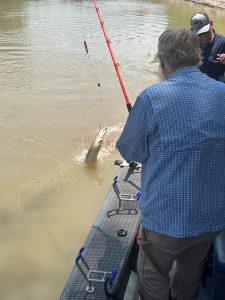 I did as I was instructed. After two more runs, interrupted by the bobber not moving, I reeled slack, then set the hook as hard as I could. Immediately whatever was on the other end of the line took off, pulling drag as it did. When it stopped and I could feel the fish shaking its head, before making a run directly toward us. I frantically cranked the reel to take in line. The fish stopped again shook her head and them turned and headed away from the boat. I held on. Then I could see line coming out of the water. The gar broke surface, tail-walked while flailing, then again hit the water. I kept reeling, finally turned her. She grudgingly came toward the boat. Twelve feet away, she again cleared water, shaking her toothy head.
I did as I was instructed. After two more runs, interrupted by the bobber not moving, I reeled slack, then set the hook as hard as I could. Immediately whatever was on the other end of the line took off, pulling drag as it did. When it stopped and I could feel the fish shaking its head, before making a run directly toward us. I frantically cranked the reel to take in line. The fish stopped again shook her head and them turned and headed away from the boat. I held on. Then I could see line coming out of the water. The gar broke surface, tail-walked while flailing, then again hit the water. I kept reeling, finally turned her. She grudgingly came toward the boat. Twelve feet away, she again cleared water, shaking her toothy head.
A couple more minutes of holding on and reeling whenever I could I started bringing her alongside so Chris could “rope her” and we could bring her aboard. He was able to do so and we did. On the bow of the boat in preparation to take photos, Tracy tagged my gar and then measured her length, 68-inches a little bit. I smiled. Not my biggest gar to date but a monster none-the-less.
My goal is to someday catch an alligator gar that exceeds 7 feet, or 84-inches in length. Chris’ clients catch several such gars each year. One of these days I would like to be one of those who lands such a monster!
Tagged, measured, photos taken we slid her back into water.
Conor and I took turns catching gar. We caught ten more gars ranging from 42 to 48-inch in length. They fought and jumped like champions. Conor also hooked and landed a 20-pound blue catfish, which like the gars we released.
When finally, the morning’s action slowed and temperatures rose well above the 100-degree mark, we decided it would be a good idea to find a tall glass of iced tea, where we could tell hunting and fishing stories. Memories made and documented with photos we headed toward a cooler place. Before doing so, we resolved to soon get together and try once again for that seven-foot or longer gar which I hope to catch, photograph and release so it can continue a long and rewarding life!
